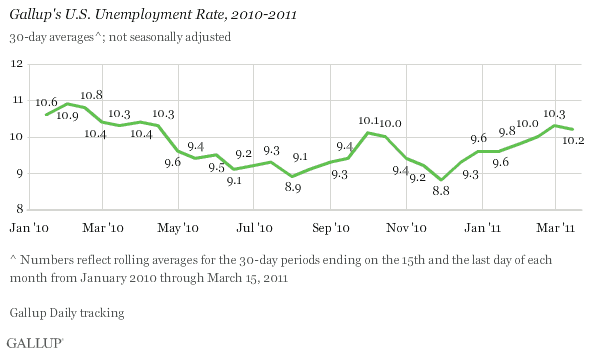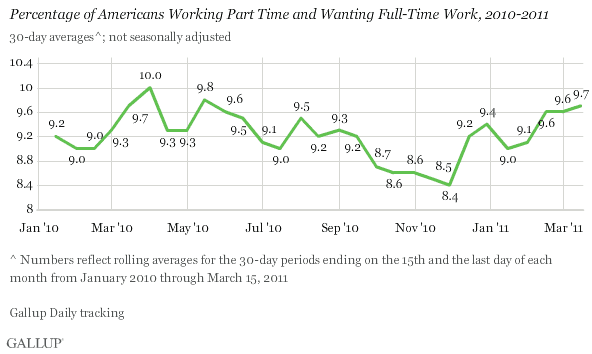PRINCETON, NJ -- Unemployment, as measured by Gallup without seasonal adjustment, was at 10.2% in mid-March -- essentially the same as the 10.3% at the end of February but higher than the 10.0% of mid-February and the 9.8% at the end of January. The U.S. unemployment rate is about the same today as the 10.3% rate Gallup found in mid-March a year ago.

The percentage of part-time workers who want full-time work was 9.7% in mid-March -- essentially unchanged from the 9.6% in both February measurements and higher than the 9.1% at the end of January. The percentage of the U.S. workforce that is working part time but wanting full-time work is the same now as was the case a year ago.

Broader Underemployment Was Unchanged in Mid-March
Underemployment, a measure that combines the percentage of part-time workers wanting full-time work with the percentage who are unemployed, was 19.9% in mid-March. Not surprisingly given the lack of change in its components, this is identical to the end-of-February reading, and is virtually the same as the 20.0% of mid-March a year ago.

Jobs Situation About the Same as It Was a Year Ago
The government's February report on the U.S. unemployment situation suggests that 192,000 jobs were created last month and the unemployment rate declined to 8.9%, down from 9.7% a year ago. Federal Reserve Bank of New York President William Dudley and others said they were encouraged by this report.
However, Gallup's unemployment and underemployment measures have not shown the same gains in early 2011. Gallup finds an unemployment rate (10.2%) and an underemployment rate (19.9%) for mid-March that are essentially the same as those from mid-March 2010.
In part, the difference between Gallup's and the government's current job market assessments may be due to the government's seasonal adjustments. Gallup's U.S. unemployment rate is also more up-to-date -- its mid-March data include jobless figures for much of March, whereas the government's latest unemployment rate is based on the jobs situation in mid-February.
Most importantly, a key reason the government's unemployment rate is dropping apparently has to do with the so-called participation rate: the percentage of Americans who are counted as being in the workforce. The government's participation rate in February was at its lowest level since 1984. In essence, this tends to suggest that the government's unemployment rate may be declining because many people are becoming discouraged and leaving the workforce -- not because they are getting new jobs.
If this is the case, then neither Gallup's unemployment report nor that provided by the government is good news for the economy. It is equally bad news if people are out of work and looking for a job or just too discouraged to say they continue to do so. Either way, a lack of sufficient job creation to increase employment among those who want to work remains a major obstacle to U.S. economic growth in the months ahead.
Gallup.com reports results from these indexes in daily, weekly, and monthly averages and in Gallup.com stories. Complete trend data are always available to view and export in the following charts:
Daily: Employment, Economic Confidence and Job Creation, Consumer Spending
Weekly: Employment, Economic Confidence, Job Creation, Consumer Spending
Read more about Gallup's economic measures.
View our economic release schedule.
Survey Methods
Gallup's U.S. employment measures report the percentage of U.S. adults in the workforce, aged 18 and older, who are underemployed and unemployed, without seasonal adjustment. "Underemployed" respondents are employed part time, but want to work full time, or are unemployed. Results for each 30-day rolling average are based on telephone interviews with approximately 30,000 adults. Because results are not seasonally adjusted, they are not directly comparable to numbers reported by the U.S. Bureau of Labor Statistics, which are based on workers aged 16 and older.
Results are based on telephone interviews conducted as part of Gallup Daily tracking from Feb. 14- March 15, 2011, with a random sample of 17,978 adults, aged 18 and older, living in all 50 U.S. states and the District of Columbia, selected using random-digit-dial sampling.
For results based on the total sample of national adults, one can say with 95% confidence that the maximum margin of sampling error is ±1 percentage point.
Interviews are conducted with respondents on landline telephones and cellular phones, with interviews conducted in Spanish for respondents who are primarily Spanish-speaking. Each daily sample includes a minimum quota of 200 cell phone respondents and 800 landline respondents, with additional minimum quotas among landline respondents for gender within region. Landline respondents are chosen at random within each household on the basis of which member had the most recent birthday.
Samples are weighted by gender, age, race, Hispanic ethnicity, education, region, adults in the household, cell phone-only status, cell phone-mostly status, and phone lines. Demographic weighting targets are based on the March 2010 Current Population Survey figures for the aged 18 and older non-institutionalized population living in U.S. telephone households. All reported margins of sampling error include the computed design effects for weighting and sample design.
In addition to sampling error, question wording and practical difficulties in conducting surveys can introduce error or bias into the findings of public opinion polls.
For more details on Gallup's polling methodology, visit www.gallup.com.
